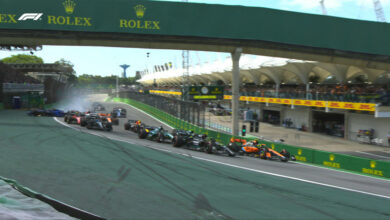How Richard Hammond Love for Muscle Cars Could Have Started in 1969
1969. Man landed on the moon. Woodstock changed music. Sesame Street changed children’s television. And 1969 was also the year of Richard Hammonds’ birth.
Hammond’s love of muscle cars is world renowned.
“There are those who don’t like muscle cars, who can’t understand their appeal and frown at them in confusion and bewilderment. And we should pity these people – pity them, but not fear them, because they are spineless and have no soul.” – Richard Hammond, 2008
Hammond himself owns several classic muscle cars. A 1969 Dodge Charger R/T and a 1967 Ford Mustang GT 390.
“The original American muscle cars were created with the idea of generating myth and legend from the start.”
These cars laid the groundwork for cementing the legacy of American muscle cars. It’s easy to see why Hammond loves and respects them so much.
 Pontiac GTO “The Judge”
Pontiac GTO “The Judge”
In 1969, a new model called “The Judge” was introduced. The name came from a comedy routine, “Here Come de Judge”, used repeatedly on the Rowan & Martin’s Laugh-In TV show.
The Judge routine, made popular by legendary showman Sammy Davis, Jr., was borrowed from the act of long-time burlesque entertainer Dewey “Pigmeat” Markham. Advertisements used slogans like “All rise for the Judge” and “The Judge can be bought.” As originally conceived, the Judge was to be a low-cost GTO, stripped of features to make it competitive with the Plymouth Road Runner.
 Ford Mustang Mach 1
Ford Mustang Mach 1
1969 was the benchmark year for Ford Mustang in its proliferation of performance names and engines. No less than 6 factory performance Mustang models were available (GT, Boss 302, Boss 429, Shelby GT350, Shelby GT500 and the Mach 1). Additionally, seven variations of V-8s were available in the ’69–’70 models; most of these also available in the new Mach 1.
Due to the Mach 1’s success, the GT model was discontinued after 1969 following poor sales of 5,396 units – versus the 72,458 sales for the Mach 1. The Mustang would not wear the “GT” badge again until 1982.
Mercury Cougar

The third year of production, 1969, brought several new additions to the Cougar lineup. A convertible model was now available in either standard and XR-7 trim. The grille switched from vertical bars to horizontal bars. Tail lights still spanned the entire rear of the car and retained vertical chrome dividers, but were now concave rather than convex. Body sides now featured a prominent line that swept downward from the nose to just ahead of the rear wheel wells.
A new performance package appeared. The GT, XR-7G, and 7.0-L GT-E were discontinued, but the 390 and 428 V8s remained. The 302 engines were dropped, except for the “Boss” version, available only with the Eliminator package. The new standard Cougar engine was a 250-horsepower 351 Windsor. A 290 hp (216 kW) 351 Windsor V8 was also added to the engine lineup. The Eliminator performance package appeared for the first time. A 351 cu in (5.8 L) four-barrel Windsor V8 was standard, with the 390 four-barrel V8, the 428CJ, and the Boss 302 available as options.
The Eliminator also featured a blacked-out grille, special side stripes, front and rear spoilers, an optional Ram Air induction system, a full gauge package including tachometer, upgraded “Decor” interior trim, special high-back bucket seats, rally wheels, raised white letter tires, and a performance-tuned suspension and handling package. It also came in vibrant colors, such as white, bright blue metallic, competition orange, and bright yellow.
Plymouth Road Runner

The 1969 model kept the same basic look, but with slight changes to the tail lights and grille, side marker lights, optional bucket seats, and new Road Runner decals.
The Road Runner added a convertible option for 1969 with 2,128 such models produced that year. All were 383 cu in (6.3 L) engine cars, except for ten which were equipped with a 426 cu in (7.0 L) Hemi.
And here are commercials from 1969 for four iconic muscle cars that helped to generate that myth.
Since Hammond already owns a Ford Mustang, I think he would choose the Mach 1, but he would be content with any of these.



